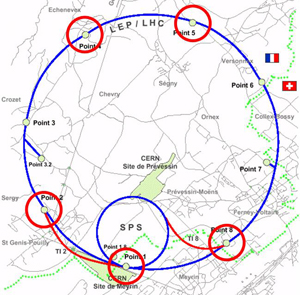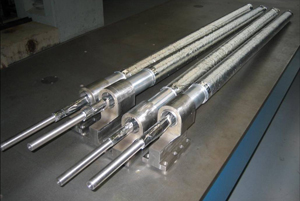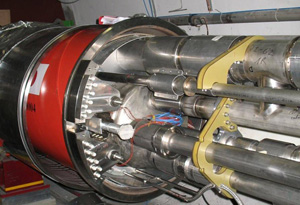Inner Triplet Successfully Completes Pressure Test
 |
| On July 13, a pressure test occured at Point 8 (lower right) in the LHC accelerator tunnel.
|
 |
| Q1 and Q3 magnets were fitted with sets of four cartridges, each consisting of an invar rod inside an aluminum tube.
|
 |
| A Q1 magnet assembly with cartridges held in place by the four earlike brackets bolted to the outer flange.
|
An inner triplet assembly of quadrupole magnets at Point 8-Right of the LHC at CERN successfully completed a pressure test in the accelerator tunnel on Friday, July 13. The triplet, which included three quadrupole magnets and the associated cryogenic and power distribution box, or DFBX, met all test specifications at the requisite pressure of 25 atmospheres for one hour. The triplets will focus particle beams prior to particle collisions at each of four interaction regions in the Large Hadron Collider, now under construction at CERN.
The pressure test is designed to test the accelerator components in conditions that will occur during LHC operations. To withstand the asymmetrical forces generated by the pressure, the Q1 and Q3 magnets, at either end of the triplet assembly had each been fitted with a set of four metal cartridges. The cartridges reinforce internal support structures that broke in two such magnets during an earlier pressure test on March 27. The cartridges limit movement of the magnets inside their metal jackets, or cryostats.
Metal brackets attach the cartridges to one end of each of the affected magnets. The cartridges have a compound design consisting of an aluminum alloy tube and an Invar rod to allow them to function over a broad range of temperatures. Invar is a form of steel whose dimensions change very little in response to temperature differences.
A team from CERN, Fermilab, Japan's KEK laboratory and Lawrence Berkeley National Laboratory also made changes to the DFBXs and to the attachment of the triplet to the tunnel floor to address design flaws that emerged during the March pressure test. These changes successfully completed the July 13 pressure test as well.
Fermilab, in collaboration with CERN and KEK, supplied eight sets of triplets, one for either side of each of the LHC's four interaction regions, plus one spare triplet. Currently about half the number of quadrupole magnets have been repaired, with the remaining repairs estimated to take about six weeks to complete. This will be followed by the installation of assemblies and interconnections between quadrupole magnets, DFBXs and the rest of the accelerator. The inner triplets will then become part of the different sectors of the LHC and will be tested as part of ongoing pressure tests of all sectors of the LHC.
Cooldown of sector 8-1, site of last week's successful pressure test, is expected to begin in late August.
LHC Magnet Update Archive
|